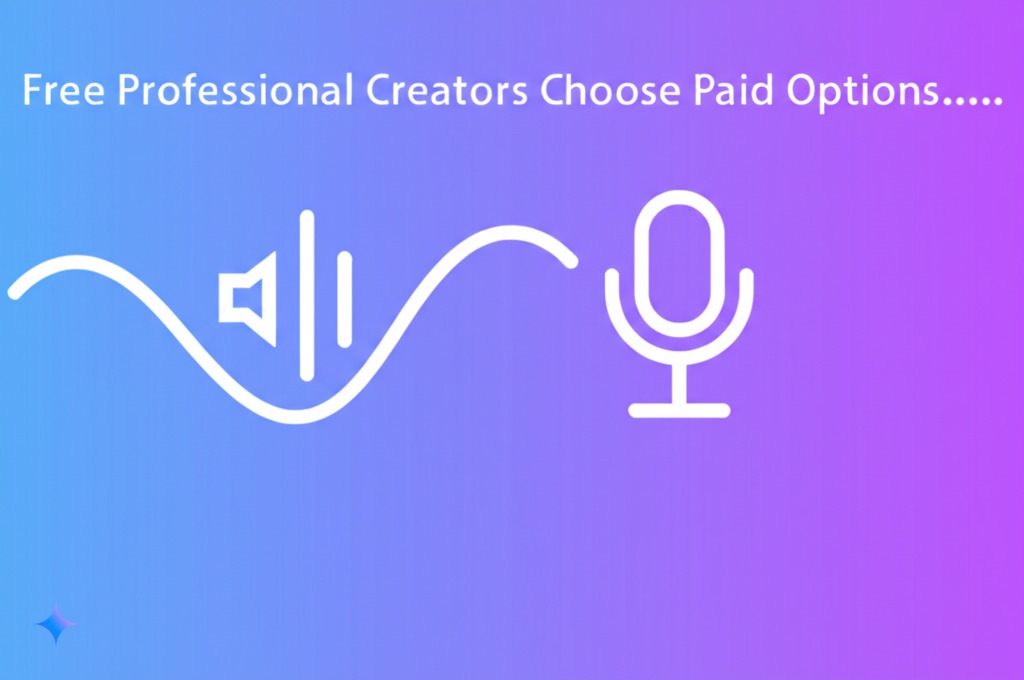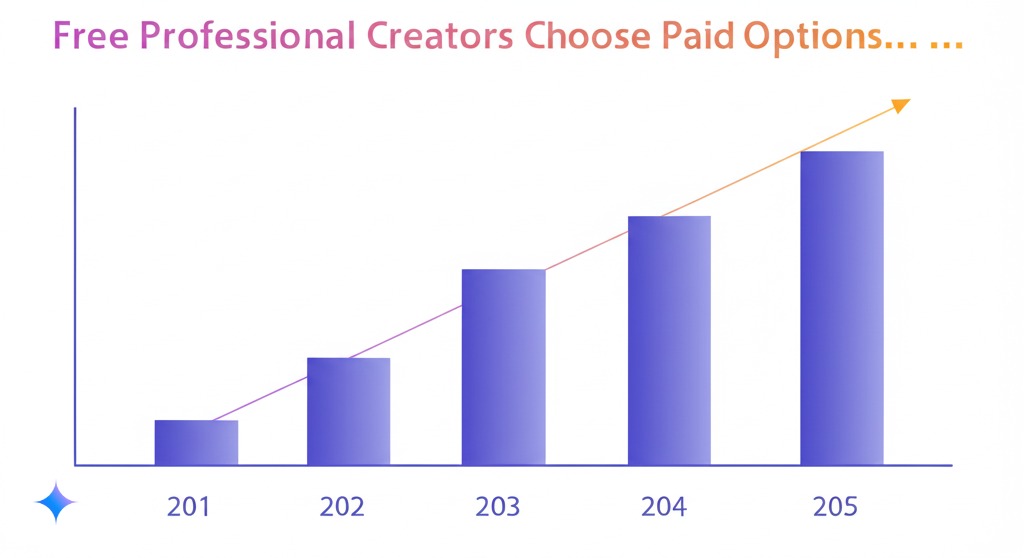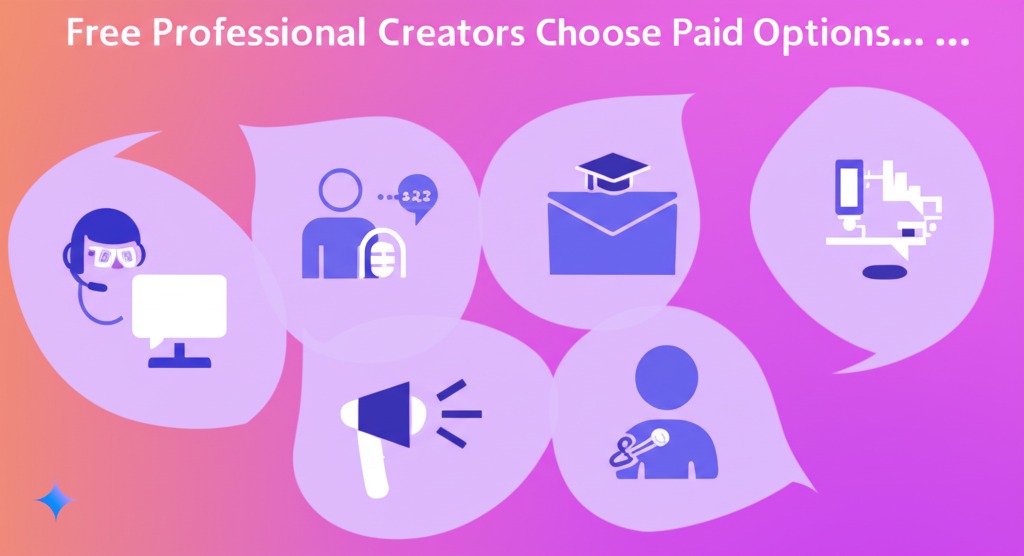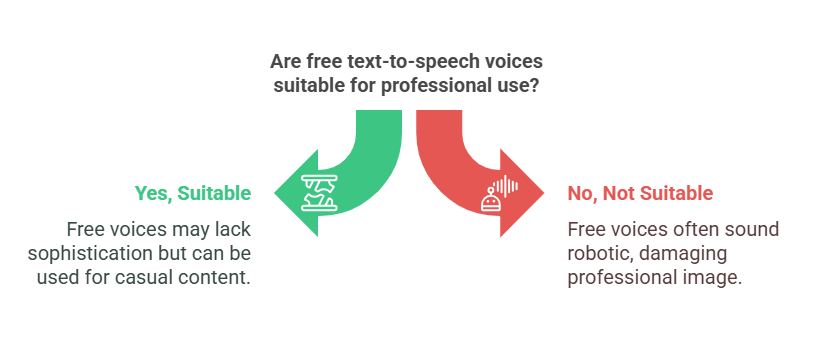
Free text to speech costs might not be obvious at first, but when creating professional content, the limitations of free tools can end up costing you more than paid options in the long run.
Introduction
Free Text to Speech Costs: Understanding the Hidden Price Tag
Free text to speech tools seem like a great deal at first glance. Who doesn’t like getting something for nothing, right? But as someone who’s spent years creating content, I can tell you there’s always a catch.
When you’re standing at the crossroads between using free text to voice services or paying for a subscription, it’s important to know what you’re really getting – and what you’re giving up.
Free text to speech costs aren’t just about money. They show up in other ways: limited features, robotic-sounding voices, strict character limits, and often no rights to use the content commercially. For casual users just playing around with the technology, these limitations might not matter much. But for anyone serious about creating audiobooks, podcasts, or YouTube videos, these restrictions can quickly become major roadblocks.
This article breaks down the real differences between free and paid text to speech options, helping you decide if sticking with free tools is actually saving you money – or costing you in ways you hadn’t considered.

The Good and Bad of Free Text to Speech
What’s Great About Free Options
Let’s start with the good stuff. The biggest plus with free text to speech tools is that anyone can try them out. You don’t need to reach for your credit card just to see what the technology can do.
Most free options are pretty simple to use, too. You can go from sign-up to hearing your first AI voice in minutes. This makes them perfect for beginners who are just curious about how speech synthesis works.
If you just need to convert text to audio for a small personal project, a free voice generator might be all you need. These tools let you test different voices and get a feel for what you like before committing to anything.
Where Free Options Fall Short
Text Length Limits That Hold You Back
Free plans are notoriously stingy with how much text you can turn into speech. For example, some free plans only let you convert 800 characters in their free tier – barely enough for a short paragraph. Others might give you just 5 minutes of credits each month, while some cap you at 12,500 characters.
These limits make free options completely impractical for bigger projects. Imagine trying to create an audiobook by breaking it into hundreds of tiny chunks! The free text to speech costs in terms of your time and patience would be enormous.
This becomes especially problematic for longer content. If you’re looking for text to speech for long documents free options, you’ll quickly hit these frustrating barriers. A typical audiobook might contain hundreds of thousands of words, making the character limits of free tools a fundamental obstacle.
Limited Voice Options That Sound Robotic
The voice quality in free text to voice tools often leaves a lot to be desired. Most text to speech software free options offer just a handful of basic voices that sound noticeably artificial. They often lack the natural flow of human speech, making them sound stiff and mechanical.
This becomes a real problem for content that needs to keep listeners engaged. Try listening to a robotic voice read a story for 30 minutes straight – it gets tough to stay focused! Natural sounding voices are rarely available in free plans.
Finding text to speech software with natural voices free is challenging because the advanced AI models that create human-like speech are expensive to develop and maintain. Companies reserve these premium voices for their paying customers.
No Commercial Rights = No Money Making
Here’s a big one: most free AI voice generator services don’t allow commercial use. This means you can’t legally:
- Sell audiobooks created with the tool
- Monetize YouTube videos using the audio
- Use the voices in podcasts that make money through ads
Most free plans explicitly prohibit commercial use of voices or require attribution. Some might even demand that you mention their service in your content.
If you’re creating content as a hobby, this might not matter. But if you’re hoping to make money from your content someday, text to speech with commercial license free options simply won’t cut it – and this hidden free text to speech costs could mean redoing all your work later.
The search for a free AI voice generator for commercial use will likely end in disappointment, as companies need to protect their investment and ensure they’re compensated when their technology is used for profit.
Bare-Bones Features
Free versions typically only offer the most basic functions. Want to clone a voice, adjust the tone or pitch, or edit the pronunciation of tricky words? You probably won’t find these features in free plans.
These limitations seriously restrict your ability to create professional-sounding content. The best free text to speech tools still can’t match the customization options of paid versions.
While some platforms offer a text to speech software with voice cloning free trial, the full functionality is almost always locked behind a paid subscription. Voice cloning technology is particularly advanced and valuable, so it’s rarely included in free tiers.
Limited or No Support When Problems Arise
When you run into problems with a free tool, you’re often on your own. Most free text to speech options offer minimal to no dedicated customer support. Instead, you’ll likely be directed to online forums where you must rely on community responses to resolve issues.
The absence of reliable technical support can lead to frustration, project delays, and an inability to resolve problems efficiently. This lack of support is yet another hidden free text to speech costs that isn’t immediately obvious.

Security and Licensing Concerns
Open-source software might sound great (who doesn’t like free stuff?), but there’s a catch. When the code is out there for everyone to see, it also means the bad guys can spot weaknesses more easily. Not exactly reassuring when dealing with important content or sensitive information.
And those licensing terms nobody reads? They can come back to bite later. Using free software without checking the fine print is like signing a contract without reading it – potentially messy down the road. Some free tools have hidden rules about how their voices can be used, and getting caught on the wrong side of those terms isn’t fun for anyone.
What You Get When You Pay for Text to Speech
Enhanced Voice Quality and a Wider Variety of Natural-Sounding Voices
Paid text to speech subscription services offer dramatically better voice quality. Instead of mechanical-sounding robots, you get access to AI voices that sound remarkably human.
Premium services typically offer hundreds of high-quality natural reading voices across many languages. These voices include different emotions, accents, and speaking styles, making them much more engaging for listeners. The difference between free and paid options? Night and day. The premium voices sound so natural that it’s getting harder to tell them apart from actual humans.
For content creators looking for the best text to speech options, it’s worth noting that free text to voice online tools often fall short in terms of voice quality and engagement, which are crucial for keeping viewers interested in your content.
Increased Text Limits and Project Scalability
Paid plans remove the frustrating character limits of free options. Instead of being cut off mid-project, you get generous or unlimited usage.
Many premium services offer unlimited character usage or provide dozens of hours of voice generation per month. This means you can finally tackle those bigger projects like full audiobooks or podcast series without constantly running into limits. Text to speech for long documents becomes simple and straightforward.
The increased capacity allows for creating full-length audiobooks, extensive podcast series, and longer YouTube videos without the constraints imposed by free plans. This scalability is essential for professional content creators who need to handle large-scale audio projects efficiently.
Full Commercial Rights for Diverse Content Creation
Perhaps the biggest advantage of paid plans is getting full commercial usage rights, allowing users to monetize their audio content across various platforms. This is essential if you want to:
- Sell audiobooks on platforms like Audible
- Monetize YouTube videos with AI narration
- Include AI voices in paid courses or commercial podcasts
For content creators looking to earn money from their work, this difference alone makes paid options worth the investment, as most text to speech with commercial license free options simply don’t exist in a meaningful way.
Advanced Features for Professional Results
Paid plans come with powerful features that let you fine-tune your audio:
- Voice cloning: Create a digital copy of a voice (including potentially your own)
- Advanced editing: Adjust pitch, tone, speed, and emphasis
- Pronunciation tools: Fix how the AI pronounces difficult words
- SSML support: Use markup language to control exactly how the text is spoken
If you’re interested in advanced features like voice cloning (creating a digital copy of a voice), you might want to explore options for free AI voice cloning first to understand the technology, before committing to paid services.
Looking for text to speech for video narration free options? Unfortunately, it’s like hunting for a unicorn. The kind of quality needed to keep viewers from clicking away requires paid features. For serious video projects, explore comprehensive AI text to speech for narration solutions that provide professional results.

Better Reliability and Help When You Need It
When you pay for text-to-speech services, they usually work more consistently and offer real people to help when something goes wrong. This saves you time and frustration when issues pop up. Knowing help is available and the service won’t randomly break down gives content creators peace of mind and makes the whole process smoother. This reliability really matters for professionals working with deadlines.
Working Offline and Connecting with Other Tools
Some paid options let you use the voice files without internet and connect them with other programs you use. These features make your workflow more efficient and flexible, so you can work anywhere and easily fit text-to-speech into your existing content creation process.
Consider what you’re making. Videos for YouTube might need different features than audiobooks. If you’re making videos, AI voice over for YouTube might require different features than audiobook narration. Understanding exactly what you need helps you pick the right service.
Many professional creators mix their own voice with AI voices. If that’s you, you’ll want to check out options for text to speech for content creators that specifically address your workflow needs.
Website Accessibility Through Voice
Website voice tools convert text into natural-sounding speech, making your site accessible to people with vision problems or reading difficulties while also improving your search rankings. These solutions help websites reach more people without spending a lot of money.
Voice technology is transforming how people experience websites. What was once just a dream – having your website read content aloud to visitors who have trouble seeing or reading – is now common practice.
This technology gives your website a voice! It helps more people use your site and can boost your Google rankings. Whether someone has vision issues, dyslexia, or simply prefers listening over reading, these tools open your content to new audiences.
Adding voice features isn’t just being considerate – it’s smart business. When more people can use your site, more people visit and stay longer. Search engines notice this and often rank your site higher. And the best part? Many quality options are completely free to set up.
A Comparative Analysis: Free vs. Paid Tiers Across Popular TTS Platforms
Let’s examine how free and paid tiers compare across several popular text to speech platforms to give you a clearer picture of what you’re getting—or missing—with free options.
Free Plans: What You Get and What You Don’t
Free text to speech plans typically come with significant limitations:
- Character Limits: Most free plans restrict you to just hundreds or a few thousand characters per conversion. Some might offer as little as 5 minutes of audio per month.
- Voice Restrictions: Free tiers generally provide access to only a small selection of basic voices, often the most robotic-sounding ones.
- Commercial Limitations: Almost universally, free plans prohibit commercial use of the generated audio or require attribution.
- Feature Constraints: Advanced features like voice customization, emotional inflection, or editing capabilities are typically locked behind paid plans.
- Quality Issues: The audio quality itself is often limited in free plans, with lower bitrates or resolution.

Paid Plans: The Upgrade Difference
When you upgrade to paid plans, the difference is substantial:
- Generous Usage: Paid tiers offer much higher limits—from hundreds of thousands of characters to unlimited usage.
- Voice Libraries: Access to hundreds of premium, natural-sounding voices across multiple languages and accents.
- Commercial Rights: Full rights to use the generated audio commercially without attribution requirements.
- Advanced Features: Voice cloning, customization options, SSML support, and editing tools become available.
- High-Quality Output: Better audio quality with higher bitrates and clearer sound.
VoiceOverMaker: Examining the Free and Subscription Models
VoiceOverMaker‘s free plan is significantly limited, offering only 800 characters and restricting usage to personal purposes. This severely restricts its utility for any substantial project.
Their paid options offer considerably higher character limits and the necessary commercial use rights for professional applications. The stark contrast between the free tier and the offerings of the paid tiers underscores the need for a subscription for serious content creation.
Murf AI: Evaluating the Value Proposition of Paid Plans
Murf.ai‘s free plan provides a mere 10 minutes of voice generation and explicitly prohibits downloads and commercial use. This makes it suitable primarily for testing the platform’s capabilities.
In contrast, their paid plans unlock features such as significantly increased voice generation time, the ability to download generated audio, commercial usage rights, access to a wider selection of voices (over 120), and even voice cloning capabilities. The substantial upgrade in features and capabilities offered by Murf.ai’s paid plans clearly demonstrates their value for professional users.
For creators looking for affordable text to speech for audiobooks, Murf.ai’s paid plans offer a compelling mix of quality and value.
LOVO AI: Understanding the Upgrades from Free to Premium
LOVO.AI‘s free plan comes with several limitations, including restricted voice options and customization, no access to AI voice cloning or premium AI voices, download limits, commercial use restrictions, and a cap on the number of projects that can be created (5).
Upgrading to their paid plans provides access to a much broader library of voices (over 500), enables AI voice cloning, offers higher-quality audio downloads, grants commercial licensing for business applications, and removes project limitations. These enhancements highlight the necessity of a paid subscription for users with professional content creation needs.
LOVO AI is particularly popular for those seeking free online voice generator for podcasts capabilities, but serious podcasters will quickly want to upgrade to access the full feature set.
Speakai: Assessing the Benefits of Subscription Options
Speakai‘s free plan, also known as the Pay-As-You-Go plan, focuses primarily on transcription. While it offers unlimited transcription, it comes at a higher rate compared to their subscription plans.
The free tier also includes a limited number of AI chat characters at a premium rate, is restricted to a single user, offers only basic functionality without premium add-ons, but does provide unlimited storage. This structure suggests that Speakai’s subscription plans likely offer more cost-effective rates for both transcription and AI chat characters, along with enhanced features and the ability to accommodate teams, making them more advantageous for regular users and collaborative projects.
Fliki: Analyzing the Features Gained with Paid Access
Fliki‘s free plan is quite restrictive, providing only 5 minutes of credits per month, access to a limited set of 300 voices, low-resolution (720p) videos with a Fliki watermark, limited access to key features, and no ultra-realistic voices or commercial rights.
In contrast, their paid plans offer significantly more credits, a wider selection of voices (including ultra-realistic and studio-quality options), higher video resolutions, the removal of watermarks, full access to all features (including translation, AI avatars, voice cloning, and custom voice), commercial rights, and priority support.
The dramatic difference in features and capabilities clearly illustrates the necessity of a paid Fliki subscription for professional video and audio content creation, especially for those seeking text to speech for video narration free alternatives.
Play.ht: Determining the Advantages of Investing in a Subscription
Play.ht‘s free plan provides a limited number of characters per month (12,500) and restricts its use to non-commercial purposes, requiring attribution for any published audio.
Upgrading to their paid plans unlocks a range of benefits, including significantly higher character limits or unlimited voice generation, commercial licenses, access to all premium voices (over 600), voice cloning capabilities, and advanced features like SSML support for fine-tuning audio output.
The transition from the limitations of the free plan to the comprehensive features and rights offered by Play.ht’s paid subscriptions highlights the value of investing in a subscription for professional use, particularly for those who need AI voiceover capabilities for commercial projects.
Comparative Table: Free vs. Paid TTS Platform Features
| Platform | Free Plan Limitations | Paid Plan Advantages |
|---|---|---|
| VoiceOverMaker | 800 characters, personal use only | Higher character limits, commercial use rights |
| Murf AI | 10 minutes generation, no downloads, no commercial rights | More generation time, downloads, commercial rights, voice cloning, more voices |
| LOVO AI | Limited voices, no voice cloning, download limits, no commercial use, project limits | More voices, voice cloning, higher quality downloads, commercial rights, unlimited projects |
| Speakai | Higher rates for transcription and AI chat, basic functionality, single user | Lower rates, more features, team collaboration |
| Fliki | 5 mins credits, limited voices, low-res with watermark, limited features, no commercial rights | More credits, wider voice selection, high-res, no watermark, full features, commercial rights |
| Play.ht | Limited characters, non-commercial use, attribution required | Higher/unlimited generation, commercial licenses, all premium voices, voice cloning, advanced features |
The True Cost of “Free”: Why Paid TTS is a More Sustainable Solution for Serious Projects
While the initial appeal of free TTS options lies in their lack of upfront cost, their inherent limitations can lead to significant drawbacks for individuals and businesses undertaking serious audio projects. The free text to speech costs can actually be quite high when you look beyond the price tag.
The time and effort dealing with free tool limitations, combined with potentially lower quality audio and no commercial usage rights, can actually make these “free” options cost you more in the end.
Think about it – free plans with character limits force you to chop your project into many small pieces, taking extra time and possibly making your final product sound disconnected. And since you can’t legally make money from audio created with free tools, content creators are missing out on potential income.
Paying for a TTS subscription gives you access to all the features, high-quality voices, and commercial rights you need to complete projects efficiently and professionally. This upfront cost actually becomes a smarter, more cost-effective solution for anyone serious about creating quality audio content.
If you’ve been searching for the best free text to speech services, consider whether those limitations match your long-term goals. If you’re creating content you hope will reach many people or generate income, investing in a paid service will likely pay off through better quality, efficiency, and proper rights management.

Specific Use Cases: When Free Isn’t Enough
Audiobook Creation
Creating audiobooks with free tools is like trying to build a house with a plastic hammer. The numbers simply don’t add up. A typical novel might be 80,000-100,000 words, far exceeding the character limits of free plans. If you’re serious about creating quality narration, you should explore how to create audiobooks with AI voice generation using paid tools.
Podcast Production
While a free online voice generator for podcasts might seem appealing for creators just starting out, the quality expectations in the podcasting space are increasingly high. For better results, check out guide on how to use AI text to speech for podcasts to learn professional approaches.
YouTube Content
YouTube creators often need a mix of their own voice and generated narration for their videos. The character limits, quality issues, and commercial restrictions of free plans make them impractical for serious YouTube content creators. For professionals looking to enhance their videos, exploring AI voice over for YouTube options is essential.
E-Learning and Training
Most e-learning content is meant to make money, which means those “no commercial use” rules on free plans are a deal-breaker from the start. For professional educational content, consider using specialized text to speech for e-learning tools that provide commercial rights and superior quality.
Frequently Asked Questions (FAQ) about Free vs. Paid Text to Speech
What’s really wrong with free text-to-speech software?
The big problems are text limits, robot-sounding voices, no commercial rights, and missing features. These make free options pretty useless for serious projects.
Can I sell stuff made with free text-to-speech?
Nope, not usually. Most free services don’t allow commercial use, so you can’t legally make money from the audio they generate.
Do free voices sound professional enough?
Rarely. They tend to sound like robots from a 90s sci-fi movie. Not the vibe most people want for their professional content.

What do I actually get when I pay for a subscription?
Better voices that sound like real humans, no text limits, commercial rights so you can make money, cool features like voice cloning and editing, and actual help when things go wrong.

How much does this stuff cost?
Monthly plans range from about $10 to $100+. Annual plans usually give you a better deal if you’re in it for the long haul.
Which platform works best for audiobooks?
High-quality services with natural-sounding voices and commercial rights are essential for audiobook creation. If you’re serious about creating audiobooks, check out this guide on how to create audiobooks with AI voice generation.
What about for podcasts?
For podcast creation, you’ll want platforms with voices that have personality and emotional range. Learn more about how to use AI text to speech for podcasts to make the right choice.
And for YouTube videos?
For video content, look for services with engaging voices and features specifically for video content. Many creators are having success with AI voice over for YouTube to enhance their content.
Can I clone voices with paid services?
Absolutely. Many premium services offer voice cloning features that let you create a digital copy of a voice. If you’re curious about this technology, you might want to explore free AI voice cloning options first before investing in a paid service.
Can I try before I buy?
Yes, most paid services offer free trials lasting from 7 to 14 days, letting you test their features before committing to a subscription.
What happens when I hit the limits on a free plan?
Either you’re cut off until next month, or you get the “upgrade now” popup. Either way, your project grinds to a halt.
Is it worth paying if I only need text-to-speech occasionally?
Even for occasional use, paid options make sense if quality matters. Some offer pay-as-you-go plans that might work better for infrequent users.
The Bottom Line: You Get What You Pay For
Free text to speech costs add up quickly when you factor in the limitations and workarounds. While free tools are fine for dipping your toes in the water, they just don’t work for serious projects.
The restrictions on text length, poor voice quality, lack of commercial rights, and missing features make free options a bad choice for audiobooks, podcasts, YouTube videos, or courses you want to sell.
On the flip side, paid subscriptions give you everything you need to create professional audio – better voices, no text limits, commercial rights, advanced features, and actual support when you need it.
For anyone serious about creating content that people actually want to listen to, a paid subscription isn’t just a cost – it’s an investment that pays off in better quality, saved time, and the ability to make money from your work.
When you think about the hours you put into creating content, doesn’t it make sense to ensure it sounds as good as possible?

Ready to Upgrade Your Audio Content?
If you’ve realized that free text to speech tools aren’t meeting your needs, it might be time to explore premium options. Here are some top services worth considering:
✅ Try LOVO.AI for ultra-realistic voices that captivate listeners ✅ Explore Play.ht for unlimited content creation with commercial rights ✅ Test Murf.ai for studio-quality audio that stands out ✅ Check out Fliki for seamless video narration ✅ Visit VoiceOverMaker for quick, professional voice creation ✅ Try Speakai for both transcription and voice generation power
Many of these platforms let you try before you buy, so you can test drive them and see which one feels right for your projects.
The bottom line? When people hear robotic voices, they quickly tune out. But when they hear natural, engaging audio, they stick around longer. It’s that simple. Investing in quality text to speech isn’t just about sounding good – it’s about keeping your audience interested and coming back for more.
For specialized content needs, you might also want to check out these guides:
- Text to speech for e-learning for educational content
- Text to speech for content creators for professional productions
- Free text to voice online options (with their limitations)
⚡ READY TO TRANSFORM YOUR CONTENT? ⚡
Don’t let robotic voices hold your amazing content back! Take the first step toward professional-sounding audio today by checking out one of the premium services above. Your audience deserves better than free robot voices!
Sources:
- https://www.speechlive.com/gb/blog/freeware-and-open-source-the-problems-with-free-speech-to-text-solutions/
- https://www.techradar.com/news/the-best-free-text-to-speech-software
- https://www.softlist.io/pros-and-cons-of-a-text-to-speech-tool/
- https://primevoices.com/blog/what-are-the-disadvantages-of-tts/
- https://listnr.ai/blog/ai-text-to-speech-free-vs-paid
- https://lovo.ai/post/ai-text-to-speech-free-vs-paid-options-whats-right-for-you
- https://speechify.com/speechify-free-vs-premium/
- https://www.neurond.com/blog/top-7-benefits-of-text-to-speech-readers
- https://www.informationaccessgroup.com/news/text_to_speech_audio_accessibility.html
- https://play.ht/blog/murf-ai-pricing/
- https://help.murf.ai/murf-api-plans-and-limits

